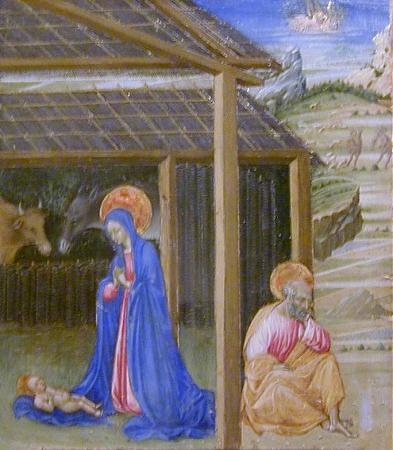Nativity. The nativity of Jesus or birth of Jesus is described in the gospels of Luke and Matthew. The two accounts differ, but agree that Jesus was born in Bethlehem in Judea during the reign of King Herod the Great, his mother Mary was married to a man named Joseph, who was descended from King David and was not his biological father, and that his birth was caused by divine intervention. Luke's version says the birth took place during the Census of Quirinius, mentions an annunciation to the shepherds, the presentation of Jesus at the Temple, and gives the name of the angel who announces the coming birth to Mary. Matthew's version mentions the arrival of the Magi, the flight into Egypt by the family, and the Massacre of the Innocents by King Herod. The consensus of scholars is that both gospels were written about AD 75-85, and while it is possible that one account might be based on the other, or that the two share common source material, the majority conclusion is that the two nativity narratives are independent of each other. The nativity is the basis for the Christian holiday of Christmas and plays a major role in the Christian liturgical year. Christian congregations of the Western tradition begin observing the season of Advent four Sundays before Christmas, the traditional feast-day of his birth, which falls on December 25. Christians of the Eastern Orthodox Church and Oriental Orthodox Church observe a similar season, sometimes called Advent but also called the Nativity Fast, which begins forty days before Christmas. Some Eastern Orthodox Christians celebrate Christmas on December 25. Other Orthodox celebrate Christmas on January 7 as a result of their churches continuing to follow the Julian calendar, rather than the modern day Gregorian calendar. The artistic depiction of the nativity has been an important subject for Christian artists since the 4th century. Artistic depictions of the nativity scene since the 13th century have emphasized the humility of Jesus and promoted a more tender image of him, as a major turning point from the early Lord and Master image, mirroring changes in the common approaches taken by Christian pastoral ministry. The date of birth for Jesus of Nazareth is not stated in the gospels or in any secular text, but a majority of scholars assume a date between 6 BC and 4 BC. The historical evidence is too ambiguous to allow a definitive dating, but the date has been estimated through known historical events mentioned in the Gospels of Luke chapter 2 and Matthew or by working backwards from the estimated start of the ministry of Jesus. Luke 2:1 states that Jesus was born when Caesar Augustus issued a decree that a census should be taken of the entire Roman world. This was the first census that took place while Quirinius was governor of Syria. All that is generally accepted is that Jesus was born before 4 BC, the year of Herod's death. The Gospels of both Matthew and Luke place the birth of Jesus in Bethlehem. Although Matthew does not explicitly state Joseph's place of origin or where he lived prior to the birth of Jesus, the account implies that the family lived in Bethlehem, and explains that they later settled in Nazareth. However, Luke 1:26-27 clearly states that Mary lived in Nazareth before the birth of Jesus, at the time of the Annunciation. The Gospel of Luke states that Mary gave birth to Jesus and placed him in a manger because there was no place for them in the inn, but does not say exactly where Jesus was born. The Greek word kataluma may be translated as either inn or guestroom, and some scholars have speculated that Joseph and Mary may have sought to stay with relatives, rather than at an inn, only to find the house full, whereupon they resorted to the shelter of a room with a manger. This could be a place to keep the sheep within the Bethlehem area, called Migdal Eder as prophesied by prophet Micah in Micah 4:8. In the 2nd century, Justin Martyr stated that Jesus had been born in a cave outside the town, while the Protoevangelium of James described a legendary birth in a cave nearby. The Church of the Nativity inside the town, built by St. Helena, contains the cave-manger site traditionally venerated as the birthplace of Jesus, which may have originally been a site of the cult of the god Tammuz. In Contra Celsum 1.51, Origen, who from around 215 travelled throughout Palestine, wrote of the manger of Jesus. The Quranic birth of Jesus, like the Gospels, places the virgin birth of Jesus in Bethlehem.
more...














